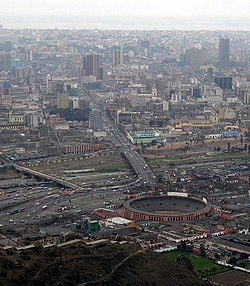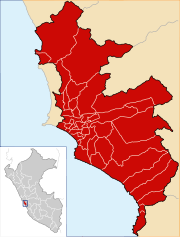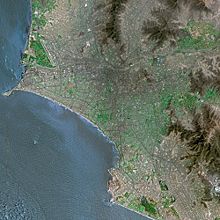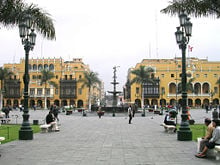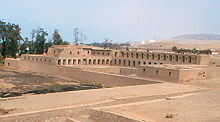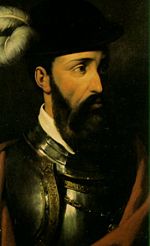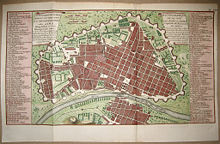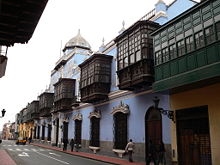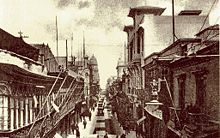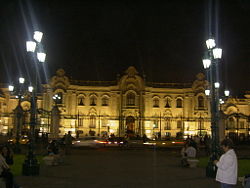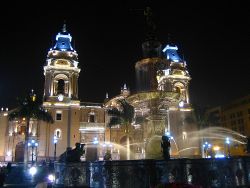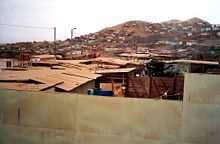Difference between revisions of "Lima" - New World Encyclopedia
Mike Butler (talk | contribs) |
Rosie Tanabe (talk | contribs) |
||
| (102 intermediate revisions by 5 users not shown) | |||
| Line 1: | Line 1: | ||
| + | {{Images OK}}{{Submitted}}{{Approved}}{{copyedited}} | ||
{{Infobox Settlement | {{Infobox Settlement | ||
<!-- Basic info ----------------> | <!-- Basic info ----------------> | ||
|official_name = Lima | |official_name = Lima | ||
|other_name = | |other_name = | ||
| − | |native_name = | + | |native_name = <!-- for cities whose native name is not in English —> |
| − | |nickname = City of | + | |nickname = City of Kings |
| − | |settlement_type = <!--For | + | |settlement_type = <!--For town or village (Leave blank for the default City)—> |
|motto = Hoc signum vere regum est | |motto = Hoc signum vere regum est | ||
<!-- images and maps -----------> | <!-- images and maps -----------> | ||
| − | |image_skyline | + | − |
| − | |imagesize | + | |image_skyline = Lima-peru.jpg |
| − | |image_caption | + | |imagesize = 250px |
| + | |image_caption = View of Lima District from the San Cristobal hill. | ||
|image_flag = Bandera de Lima.png | |image_flag = Bandera de Lima.png | ||
|flag_size = 120px | |flag_size = 120px | ||
|image_seal = Escudolima.PNG | |image_seal = Escudolima.PNG | ||
|seal_size = 75px | |seal_size = 75px | ||
| − | |image_shield = | + | |image_shield = |
|shield_size = | |shield_size = | ||
| − | |image_blank_emblem | + | |image_blank_emblem = |
| − | |blank_emblem_size | + | |blank_emblem_size = |
|image_map = Districts of Lima.svg | |image_map = Districts of Lima.svg | ||
|mapsize = 180px | |mapsize = 180px | ||
|map_caption = [[Lima Province]] and Lima within [[Peru]] | |map_caption = [[Lima Province]] and Lima within [[Peru]] | ||
<!-- Location ------------------> | <!-- Location ------------------> | ||
| + | |coordinates_region = PE | ||
|subdivision_type = [[Country]] | |subdivision_type = [[Country]] | ||
| − | |subdivision_name = | + | |subdivision_name = [[Peru]] |
|subdivision_type1 = [[Administrative divisions of Peru|Region]] | |subdivision_type1 = [[Administrative divisions of Peru|Region]] | ||
|subdivision_name1 = [[Lima Region]] | |subdivision_name1 = [[Lima Region]] | ||
|subdivision_type2 = [[Provinces of Peru|Province]] | |subdivision_type2 = [[Provinces of Peru|Province]] | ||
|subdivision_name2 = [[Lima Province]] | |subdivision_name2 = [[Lima Province]] | ||
| + | |subdivision_type3 = [[Districts of Peru|Districts]] | ||
| + | |subdivision_name3 = [[List of districts of Lima|43 districts]] | ||
<!-- Politics -----------------> | <!-- Politics -----------------> | ||
| − | |government_footnotes | + | |government_footnotes = |
| − | |government_type | + | |government_type = [[Mayor–council government]] |
| − | |leader_title | + | |leader_title = [[List of mayors of Lima|Mayor]] |
| − | |leader_name | + | |leader_name = [[Susana Villarán]] |
| − | |leader_title1 | + | |leader_title1 = |
| − | |leader_name1 | + | |leader_name1 = |
| − | |leader_title2 | + | |leader_title2 = |
| − | |leader_name2 | + | |leader_name2 = |
| − | |leader_title3 | + | |leader_title3 = |
| − | |leader_name3 | + | |leader_name3 = |
| − | |leader_title4 | + | |leader_title4 = |
| − | |leader_name4 | + | |leader_name4 = |
| − | |established_title | + | |established_title Settled |
| − | |established_date | + | |established_date = January 18, 1536 |
| − | |established_title2 | + | |established_title2 = <!-- Incorporated (town) —> |
| − | |established_date2 | + | |established_date2 = |
| − | |established_title3 | + | |established_title3 = <!-- Incorporated (city) —> |
| − | |established_date3 | + | |established_date3 = |
<!-- Area ---------------------> | <!-- Area ---------------------> | ||
| − | |area_magnitude | + | |area_magnitude = 1 E8 |
| − | |unit_pref | + | |unit_pref = <!--Enter: Imperial, if Imperial (metric) is desired—> |
| − | |area_footnotes | + | |area_footnotes = |
| − | |area_total_km2 | + | |area_total_km2 = 2672.3 |
| − | |area_land_km2 | + | |area_land_km2 = <!--See table @ Template:Infobox settlement for details on automatic unit conversion—> |
| − | |area_water_km2 | + | |area_water_km2 = |
| − | |area_total_sq_mi | + | |area_total_sq_mi = |
| − | |area_land_sq_mi | + | |area_land_sq_mi = |
| − | |area_water_sq_mi | + | |area_water_sq_mi = |
| − | |area_water_percent | + | |area_water_percent = |
| − | |area_urban_km2 | + | |area_urban_km2 = 800 |
| − | |area_urban_sq_mi | + | |area_urban_sq_mi = |
| − | |area_metro_km2 | + | |area_metro_km2 = 2819.3 |
| − | |area_metro_sq_mi | + | |area_metro_sq_mi = |
| − | |area_blank1_title | + | |area_blank1_title = |
| − | |area_blank1_km2 = | + | |area_blank1_km2 = |
| − | | | + | |area_blank1_sq_mi = |
| + | <!-- Elevation --------------------------> | ||
| + | |elevation_footnotes = <!--for references: use tags—> | ||
| + | |elevation_m = 0–1548 |elevation_m = 0–1548 | ||
| + | |elevation_ft = 0–5079 | ||
<!-- Population -----------------------> | <!-- Population -----------------------> | ||
| − | |population_as_of | + | |population_as_of = 2007 |
| − | |population_footnotes | + | |population_footnotes =<ref name="INEI Censo 2007">Instituto Nacional de Estadística e Informática, [http://www.inei.gob.pe/Anexos/libro.pdf ''Perfil Sociodemográfico del Perú''] pp. 29–30, 32, 34. Retrieved May 15, 2012.</ref> |
| − | |population_note = | + | |population_note = |
| − | |population_total = | + | |population_total = 7605742 |
| − | |population_density_km2 = | + | |population_density_km2 = 2846.1 |
| − | |population_density_sq_mi = | + | |population_density_sq_mi = |
| − | |population_metro = | + | |population_metro = 8472935 |
| − | |population_density_metro_km2 = | + | |population_density_metro_km2 = 3008.7 |
| − | |population_density_metro_sq_mi = | + | |population_density_metro_sq_mi = |
| − | |population_urban = | + | |population_urban = |
| − | |population_density_urban_km2 = | + | |population_density_urban_km2 = |
| − | |population_density_urban_sq_mi = | + | |population_density_urban_sq_mi = |
| − | |population_blank1_title = | + | |population_blank1_title = [[Demonym]] |
| − | |population_blank1 = | + | |population_blank1 = Limean ({{lang-es|Limeño/a|links=no}}) |
| − | |population_density_blank1_km2 = | + | |population_density_blank1_km2 = |
|population_density_blank1_sq_mi= | |population_density_blank1_sq_mi= | ||
<!-- General information ---------------> | <!-- General information ---------------> | ||
| − | |timezone = PET | + | |timezone = [[Time in Peru|PET]] |
| − | |utc_offset = | + | |utc_offset = −5 |
| − | + | |latd =12 | |
| − | + | |latm =2 | |
| − | |latd=12|latm = | + | |lats =36 |
| − | |longd=77|longm=1 | + | |latNS =S |
| − | | | + | |longd =77 |
| − | + | |longm =1 | |
| − | + | |longs =42 | |
| + | |longEW =W | ||
| + | |coordinates_display=8 | ||
<!-- Area/postal codes & others --------> | <!-- Area/postal codes & others --------> | ||
|postal_code_type = <!-- enter ZIP code, Postcode, Post code, Postal code... —> | |postal_code_type = <!-- enter ZIP code, Postcode, Post code, Postal code... —> | ||
| Line 102: | Line 113: | ||
|blank1_info = | |blank1_info = | ||
|website = [http://www.munlima.gob.pe/ www.munlima.gob.pe] | |website = [http://www.munlima.gob.pe/ www.munlima.gob.pe] | ||
| − | |footnotes = | + | |footnotes = |
}} | }} | ||
| − | |||
| − | Lima | + | '''Lima''' is the [[capital]] and largest city, as well as the commercial and industrial center, of [[Peru]]. It is located in the valleys of the [[Chillón River|Chillón]], [[Rímac River|Rímac]], and [[Lurín River]]s, overlooking the [[Pacific Ocean]], and forms a contiguous urban area with the seaport of [[Callao]], which is about eight miles (13 km) away on the coast. |
| − | ==Geography== | + | [[Spain|Spanish]] [[conquistador]] [[Francisco Pizarro]] founded the city in 1535, as ''La Ciudad de los Reyes,'' or "The City of Kings." It became the most important city in the Spanish [[Viceroyalty of Peru]] and, after independence, was made the capital of the Republic of Peru. The [[Historic Centre of Lima|city's historic center]] was declared a [[UNESCO]] [[World Heritage Site]] in 1988, due to its large number of historical buildings dating from the Spanish colonial era. |
| − | [[Image:Lima SPOT 1048.jpg|thumb|left| | + | {{toc}} |
| − | [[Image: | + | During the latter half of the twentieth century, unprecedented [[poverty]] and violence in the [[Andes|Andean]] highlands forced hundreds of thousands of [[Amerindian]] [[peasant]]s to migrate to Lima, bringing an exponential increase in its population. |
| − | The name ''Lima'' may derive from the [[Quechuan languages|Quechuan]] | + | |
| + | ==Geography and cityscape== | ||
| + | [[Image:Lima SPOT 1048.jpg|thumb|left|220px|Lima seen from Spot satellite.]] | ||
| + | [[Image:Square in Lima Peru 01.jpg|thumb|left|220px|The Plaza Mayor of Lima.]] | ||
| + | The name ''Lima'' may derive from the [[Quechuan languages|Quechuan]] word ''Rimac'' ("talker"), which is the name of a [[river]] that flows through the city. Some speculate that the Spanish created the word ''Lima'' in trying to say ''Rimac,'' which they heard from local inhabitants. On the oldest Spanish maps of [[Peru]], both ''Lima'' and ''Ciudad de los Reyes'' can be seen together as names for the city. | ||
| − | + | Lima is an oasis in a barren, unvegetated, mostly flat [[desert]] of grayish-yellow [[sand]]s in the [[Sechura Desert|Peruvian coastal plain]], within the valleys of the [[Chillón River|Chillón]], [[Rímac River|Rímac]], and [[Lurín River|Lurín]] rivers. The city slopes gently from the shores of the [[Pacific Ocean]] into valleys and [[mountain]] slopes 1,640 feet (500 meters) above sea level. Within the city exist isolated hills. The San Cristobal hill in the Rimac district, which faces directly north of the downtown area, is an Andean hill outgrowth. | |
| − | Lima is an | + | Although Lima is located in the tropics, the cool offshore Humboldt Current creates a temperate [[climate]] with high humidity. The [[temperature]]s vary from mild to warm, with an average maximum daytime temperature in January of 82.4°F (28°C), dropping to an average maximum of around 66.2°F (19°C) in June. Relative humidity is high, and produces brief morning [[fog]] from June to December, and persistent low [[cloud]]s from May to November. The high humidity means [[rust]] is a common sight. The peak of the "rainy season" occurs during winter when late-night/morning drizzle becomes frequent, leaving a light coating of dampness on the ground. Mean annual precipitation is 1.69 inches (43 mm). |
| − | + | Rapid population growth has brought problems of [[air pollution]], resulting from an excess of buses and cars. In July 2001, the amount of [[nitrogen dioxide]] (NO<sub>2</sub>) was of 236.66 mg/m³, the maximum allowable quantity being 100 mg/m³ | |
| − | + | Lima has had a [[water]] problem. While potable water was obtained from the Rímac and from wells, it is piped in from lakes and diverted rivers in the [[Andes]]. | |
| − | Metropolitan Lima has an area of 1031.77 square miles (2672.28 square kilometers), of which 318.87 square miles (825.88 square kilometers), or 31 percent, comprises the actual city and 712.8 square miles (1846.40 square kilometers), 69 percent, the city outskirts. The urban area extends around | + | Metropolitan Lima has an area of 1031.77 square miles (2672.28 square kilometers), of which 318.87 square miles (825.88 square kilometers), or 31 percent, comprises the actual city and 712.8 square miles (1846.40 square kilometers), 69 percent, the city outskirts. The urban area extends around 37 miles (60 km) from north to south and around 19 miles (30 km) from west to east. |
| − | The city center is located 15 km inland at the shore of the Rimac river, | + | The city center is located 9.3 miles (15 km) inland at the shore of the Rimac river, which fuels the hydroelectrical dams that provide [[electricity]] to the area. |
| − | + | The city's [[Historic Centre of Lima|historic center]], laid out by [[Spain|Spanish]] colonists in the sixteenth century, is bordered on the north by the Rímac, and is home to most of the vestiges of Lima's [[Colonialism|colonial]] past, the Presidential Palace, the metropolitan municipal council, the cathedral, the Archbishop’s Palace, and dozens of hotels. Rímac, an old colonial suburb north of the Rimac River, has narrow streets with single-story houses. The historic center of Lima was declared a [[UNESCO]] [[World Heritage Site]] in 1988. | |
| − | |||
| − | [[ | ||
| − | The | + | The upscale [[San Isidro District|San Isidro]] district is the city's financial center, and has many parks, including Parque El Olivar. [[Miraflores District|Miraflores]] has luxury hotels, shops, restaurants, as well as Larcomar, a popular shopping mall and entertainment center built on cliffs overlooking the [[Pacific Ocean]]. [[La Molina]] and [[Santiago de Surco]], home to the American [[Embassy]] and the exclusive Club Polo Lima respectively, are the other two wealthy districts of Lima, with wealth being concentrated in small pockets of the city's other districts. |
| − | The | + | The most densely-populated districts of Lima lie in the northern and southern ends of the city ([[Cono Norte]] and [[Cono Sur]], respectively), and are mostly composed of Andean immigrants who arrived during the mid and late 20th century seeking better living standards and economic opportunities, or as refugees of the country's internal conflict with the [[Shining Path]] [[guerrilla warfare|guerrillas]] during the late 1980s and early 1990s. |
| − | + | Barranco, which borders [[Miraflores District|Miraflores]] by the [[Pacific Ocean]], is known as the city's bohemian district, and has numerous restaurants, [[music]] venues called "peñas" featuring the traditional folk music of coastal [[Peru]] ("música criolla"), and beautiful Victorian-style chalets. | |
| − | |||
| − | |||
| − | |||
| − | |||
| − | |||
| − | Barranco, which borders [[Miraflores District|Miraflores]] by the [[Pacific Ocean]], is known as the city's bohemian district, | ||
==History== | ==History== | ||
| − | + | [[Image:Pachacamac.jpg|thumb|right|220px|[[Pachacamac]] temple.]] | |
| − | [[Image:Pachacamac.jpg|thumb|right| | + | [[Image:Francisco Pizarro.jpeg|thumb|150px|Francisco Pizarro.]] |
| − | [[Image:Lima1750.jpg|thumb|right| | + | [[Image:Lima1750.jpg|thumb|right|220px|Map of Lima surrounded by its [[Lima City Walls|city walls]] in 1750.]] |
| − | + | [[Image:Casa de Osambela.JPG|thumb|right|220px|Balconies were a feature of Lima's architecture during the colonial period.]] | |
| + | [[Image:Unionstreet-1930s.jpg|thumb|right|220px|''Jirón de la Unión'' was the main street of Lima in the early twentieth century.]] | ||
| − | The | + | [[Image:Lima Peru b&w.jpg|thumb|right|220px|Lima in the evening.]] |
| + | The earliest evidence of human presence in Peru has been dated to 11,000 years B.C.E. The [[Norte Chico civilization]] flourished along the coast of the [[Pacific Ocean]] between 3000 and 1800 B.C.E..<ref>Jonathan Haas, Winifred Creamer, and Alvaro Ruiz, "Dating the Late Archaic occupation of the Norte Chico region in Peru," ''Nature'' 432 (7020): 1020.</ref> These early developments were followed by the [[Chavín culture|Chavin]], [[Paracas culture|Paracas]], [[Mochica Culture|Mochica]], [[Nazca culture|Nazca]], [[Huari Culture|Wari]], and [[Chimú culture|Chimu]] cultures. In the fifteenth century, the [[Incas]] emerged as a powerful state which, in the span of a century, formed the largest empire in [[pre-Columbian America]].<ref>Terence N. D'Altroy, ''The Incas'' (Malden, Mass: Blackwell, 2002, ISBN 9780631176770), 2–3.</ref> During the early sixteenth century, the location of what became the city of Lima was inhabited by several [[Indigenous peoples of the Americas|amerindian]] groups under the domination of the [[Inca Empire]]. The temple of Pachacamac, located 40km southeast of Lima, in the Valley of the Lurín River, which dates from 200 C.E., was an important administrative center under Inca rule. | ||
| − | + | ===Spanish conquest=== | |
| + | Attracted by reports of a rich and fabulous kingdom, the Spanish [[conquistador]] [[Francisco Pizarro]] (c. 1471 or 1476–1541) and his brothers, arrived in 1532, when the [[Inca Empire]] was preoccupied by a five-year [[War of the two brothers|civil war]] between two princes, [[Huáscar]] and [[Atahualpa]]. On November 16, 1532, while the natives were celebrating, the Spanish captured the Inca Atahualpa by surprise during the [[Battle of Cajamarca]]. Despite fulfilling his promise of filling one room 22 feet (seven meters) long by 17 feet (five meters) wide with [[gold]] and two with [[silver]],<ref>''Catholic Encyclopedia,'' [http://www.newadvent.org/cathen/12140a.htm Francisco Pizarro.] Retrieved September 19, 2008. </ref> Atahualpa was convicted of killing his brother and plotting against Pizarro and his forces, and was executed by [[garrote]] on July 26, 1533. Much of the ransom demanded for Atahualpa was obtained from Pachacamac. | ||
| − | + | Pizarro initially chose the city of [[Jauja]] as his capital but founded his new capital on January 18, 1535, as ''Ciudad de los Reyes,'' at a bridgeable point on the Rímac River. In August 1536, the troops of Inca rebel [[Manco Inca Yupanqui|Manco Inca]] besieged the new city. The Spaniards and their native allies defeated the rebels after heavy fighting in the city streets.<ref> Hemming, ''The Conquest,'' 203–206. </ref> On November 3, 1536, the Spanish Crown confirmed the city's founding and, on December 7, 1537, emperor [[Charles V, Holy Roman Emperor|Charles V]] granted a coat of arms to the city. | |
| − | |||
| − | + | The city gained prestige as it was designated capital of the [[Viceroyalty of Peru]] and site of a ''Real Audiencia'' (an appellate court) in 1543. The Western Hemisphere's first [[university]], [[National University of San Marcos|San Marcos University]] was established in 1551, and its first [[printing press]] installed in 1584. A [[Roman Catholic]] [[diocese]] was established in 1541, and converted to an archdiocese five years later. | |
| − | + | The city flourished during the seventeenth century as the center of an extensive trade network which extended as far as [[Europe]] and the [[Philippines]].<ref>Margarita Suárez, ''Desafíos transatlánticos,'' 252–253.</ref> However, it also suffered considerable damage from two [[earthquake]]s in 1630 and 1687. A constant danger to the city's commerce was the presence of [[piracy|pirates]] and [[privateer]]s in the [[Pacific Ocean]]. To protect the city against them, Viceroy [[Melchor de Navarra y Rocafull]] built a wall between 1684 and 1687. An earthquake struck on October 28, 1746, devastating the city, although Lima was rebuilt in a grandiose style. | |
| − | == | + | ===Independence=== |
| − | [[ | + | [[Mining]] and [[textile]] production declined, and [[Tupac Amaru II]] (1742-1781) led an [[Indigenous peoples of the Americas|indigenous]] rebellion from 1780 to 1781. A Creole rebellion in the city of Huánuco arose in 1812. The Viceroyalty of Peru succumbed to campaigns of [[Simón Bolivar]] (1783-1830) and [[Jose de San Martin]] (1778-1850), who proclaimed the independence of Peru in Lima on July 28, 1821. |
| − | |||
| − | + | Lima became the capital of the Republic of Peru but economic stagnation and political turmoil brought its development to a halt until the 1850s, when increased public and private revenues from [[guano]] exports brought rapid expansion, with construction of the Central Market, the General Slaughterhouse, the Mental Asylum, the Penitentiary, and the Dos de Mayo Hospital. A railroad line between Lima and Callao was completed in 1850, the [[iron]] Balta Bridge across the Rímac River was opened in 1870, and the city walls were torn down in 1872. | |
| − | |||
| − | |||
| − | |||
| − | |||
| − | Lima | + | ===Lima occupied=== |
| + | During the 1879–1883 [[War of the Pacific]], with [[Bolivia]] against [[Chile]], Chilean troops occupied Lima after the battles of [[Battle of San Juan|San Juan]] and [[Battle of Miraflores|Miraflores]], destroying parts of the city. As downtown Lima had become overcrowded, the [[La Victoria District, Lima|La Victoria]] residential area was established in 1896 as a working class neighborhood. Thousands of [[France|French]], [[Italy|Italians]] and [[Germany|Germans]] migrated to Lima during the early twentieth century. | ||
| − | + | ===Earthquake=== | |
| + | On May 24, 1940, an [[earthquake]] destroyed most of the city, mostly built out of ''adobe'' and ''quincha''. In the 1940s, immigration from the [[Andes|Andean]] regions began a period of rapid growth. The population at that time was estimated at 600,000. During [[World War II]], Peru was the first [[South America]]n nation to align with the [[United States]] and its allies against [[Germany]] and [[Japan]]. | ||
| − | + | ===Rapid population growth=== | |
| + | During the latter half of the twentieth century, unprecedented [[poverty]] and violence in the Andean highlands forced hundreds of thousands of peasants of Amerindian descent to migrate to Lima, bringing an exponential increase in Lima's population.<ref name="ineidemosocio">{{es icon}} Instituto Nacional de Estadística e Informática, [http://www.inei.gob.pe/biblioineipub/bancopub/Est/LIb0002/cap0101.htm ''Lima Metropolitana perfil socio-demográfico.''] Retrieved August 12, 2007. </ref> Growth far outstripped public services, giving rise to large [[shanty town]]s, known as ''[[pueblos jóvenes]],'' areas which often lack [[electricity]] and running [[water]]. | ||
| − | + | ==Government== | |
| + | [[Image:Palacenight.JPG|thumb|250px|right|The presidential palace at night.]] | ||
| + | [[Peru]] is a constitutional republic. The president is both the chief of state and head of government, and is elected by popular vote for a five-year term, being eligible for a non-consecutive re-election. The unicameral Congress of the Republic of Peru has 120 members elected by popular vote to serve five-year terms. | ||
| − | + | The province of Lima is divided into 43 districts which are administered by the Metropolitan Lima Municipal Council.<ref> ''Municipalidad Lima,'' [http://www.munlima.gob.pe/ Municipalidad Metropolitana de Lima.] Retrieved September 19, 2008. </ref> The city proper of [[Lima]] is formed by 30 of these districts. The remaining 13 districts consist of sparsely populated [[desert]] and [[mountain]]ous areas. | |
| − | |||
| − | + | Each district is headed by a local mayor. The Mayor of Lima has authority over these and the 13 outer districts of the Lima province. The historic Lima District (Cercado de Lima) is the core of the Lima Metropolitan Area, one of the 10 largest metropolitan areas in the Americas. | |
| − | + | Each province and district is administratively autonomous, creating an obstacle to citywide planning and development. Since most municipalities have only enough money to run basic services, lack of finances has hindered inner-city renewal and suburban expansion. | |
| − | |||
| − | + | ==Economy== | |
| + | [[Image:San isidro-lima.PNG|thumb|right|225px|Lima's financial district, San Isidro.]] | ||
| + | Abundant [[mineral]] resources are found in [[Peru]]'s mountainous areas, and coastal waters provide excellent [[fishing]] grounds. However, over-dependence on minerals and metals subjects the economy to fluctuations in world prices, and a lack of infrastructure deters trade and investment. | ||
| + | The Peruvian economy grew by more than four percent each year during the period 2002-06, with a stable exchange rate and low inflation. Even so, under-employment and [[poverty]] have stayed persistently high. Peru's per capita GDP was estimated at $7800 in 2007. In 2004, Lima's [[GDP]] represented 45 percent of Peru's GDP (five percent more than the previous year). The GDP per capita was also higher in Lima. | ||
| − | + | Lima is the industrial and financial center of Peru. It contains more than two thirds of its industrial production, most of its [[tertiary sector]], and is home to many national companies. Most foreign companies operating in the country are located in Lima. The metropolitan area has approximately 7,000 factories which benefit from the city's developed infrastructure. The size of Lima’s population provides a large, skilled workforce, and makes the city Peru's main market. However, the presence of thousands of street vendors is evidence of the uncertainty of paid employment in Lima. | |
| − | |||
| − | [[ | ||
| − | |||
| − | |||
| − | |||
| − | |||
| − | |||
| − | + | [[Textile]]s, [[clothing]], and [[food]] are Lima's most important industries. [[Chemical]]s, [[fish]], [[leather]], and oil derivatives are also manufactured and/or processed in Lima. Much of the industrial activity takes place in the area stretching west of Downtown Lima to the airport in Callao. | |
| − | The | + | The [[Pan-American Highway]] and the Central Highway connect Lima to the rest of [[Peru]], and there are three expressways in the city. Lima had a rapid transit rail system, called the [[Lima Metro]], under development in 2008. [[Jorge Chávez International Airport]] in Lima is Peru's main hub for both national and international air traffic. |
| − | + | The Callao [[seaport]] is one of the main fishing and commerce ports in [[South America]], with 75 percent of the country's imports and exports using it as their entry/departure point. The main export goods through Callao are [[oil]], [[steel]], [[silver]], [[zinc]], [[cotton]], [[sugar]], and [[coffee]]. | |
| − | + | ==Demographics== | |
| + | [[Image:Lima Cathedral.jpg|thumb|right|250px|Lima Cathedral, Lima, Peru]] | ||
| + | With a municipal population of 7,605,743 and 8,472,935 for the metropolitan area, and a population density of 3,008.8 inhabitants per square kilometer (7,793 /sq mi) as of 2007,<ref name="INEI Censo 2007"/> Lima ranks as the 27th most populous 'agglomeration' in the world. Its population features a very complex mix of racial and ethnic groups. | ||
| − | + | Traditionally, ''[[Mestizos]]'' of mixed [[Europe]]an (mostly [[Spanish people|Spanish]]) and [[Amerindian]] descent are the largest contingent of Lima's ethnic groups. The second group has its origins in Europe, mostly of [[Spaniards|Spanish]] descent, but there are significant numbers of [[Italy|Italians]], [[Germany|Germans]], [[Jew]]s, and [[Middle East]]erners. [[Afro-Peruvians]], whose [[Africa]]n ancestors were brought in as [[Slavery|slaves]], and [[Asia]]ns, also form a part of the city's ethnic quilt. | |
| − | + | [[Spanish language|Spanish]] and [[Quechua]] are the official [[language]]s of Peru, while Aymara, and a large number of minor [[Amazon]]ian languages are also spoken. Most of the peasant population that has migrated to Lima speaks primarily Quechua or [[Aymara]], rather than Spanish. | |
| − | + | Peru has prided itself on being a [[Catholic]] country since the late 1500s. Roman Catholics made up 81 percent of the population in 2003, [[Seventh Day Adventist]] 1.4 percent, other [[Christian]] 0.7 percent, other 0.6 percent, unspecified or none 16.3 percent. | |
| − | |||
| + | The city has the largest concentration of higher-[[education]] institutions in [[Peru]]. The [[National University of San Marcos]], founded in 1551, is the oldest continuously functioning [[university]] in the Americas. Other public universities include the [[Universidad Nacional Agraria La Molina]] where ex-president [[Alberto Fujimori]] once taught, [[Universidad Nacional de Ingeniería]], among others. Private universities include the [[Pontificia Universidad Católica del Perú]], [[Universidad de Lima]], [[Universidad Científica del Sur]], [[Universidad San Martín de Porres]], [[Universidad del Pacifico]], [[Universidad Inca Garcilaso de la Vega]], [[Universidad Peruana Cayetano Heredia]], [[Universidad Peruana de Ciencias Aplicadas]] and [[Universidad Ricardo Palma]]. | ||
| − | == | + | ==Society and culture== |
| − | [[Image: | + | [[Image:Limean Archbishop's Palace.jpg|220px|thumb|right|The Archbishops palace. To the left, the House of the Oidor.]] |
| − | [[Image:Lima | + | [[Image:Lima PuebloJov 4.jpg|thumb|right|220px|Slums in the outskirts of Lima.]] |
| − | The [[Historic | + | The [[Historic Centre of Lima]] was declared a [[UNESCO]] [[World Heritage Site]] in 1988 due to its large number of historical buildings dating from the Spanish colonial era. Lima is home to the most prestigious national [[museum]]s, including the National Museum of Anthropology, Archaeology, and History, and the Rafael Larco Herrera Archaeological Museum, both in the [[Pueblo Libre]] district, the Museum of the Nation, the Museum of Art, the Museum of Italian Art, the Museum of the Inquisition, and many others. Lima has a world renowned cuisine, which fuses Andean and Spanish culinary traditions. Locations of interest include: |
| + | * The Plaza Mayor, which is where [[Pizarro]] founded Lima in 1535, and where where Independence was proclaimed in 1821. Located in the [[Historic Centre of Lima]], it is surrounded by the Government Palace, the Cathedral of Lima, the Archbishop's Palace of Lima, and the Municipal Palace. | ||
| − | + | * The Basilica Cathedral of Lima, which is a [[Roman Catholic]] cathedral located in the Main Plaza, contains the tomb of the conqueror [[Francisco Pizarro]], who placed the cathedral's first stone. Construction started in 1535. | |
| − | The | + | * The Presidential Palace, which is the official Residence of the President of Peru, and the seat of the executive offices. It was built over a huge Indian burying ground. |
| − | + | * The Convento de San Francisco, which is noted for its seventeenth century [[architecture]], a high example of [[Spain|Spanish]] [[Neoclassicism]], and for [[catacombs]] built under the monastery, which are said to connect to catacombs beneath the [[cathedral]] and other churches. The church was completed in 1674. | |
| + | Many small beaches, which are heavily visited during the summer months, are located along the southern [[Pan-American Highway]]. The most well-known are those located in the districts of [[Santa María del Mar]], [[Punta Hermosa]], [[Punta Negra]], [[San Bartolo]] and [[Pucusana District|Pucusana]]. | ||
| + | ==Looking to the future== | ||
| + | Lima benefits from it's position as the [[capital]], largest city, and commercial and industrial center of [[Peru]], as well as from the steady flow of tourists visiting [[World Heritage Site]]s at the [[Historic Centre of Lima|city's center]], and inland at [[Cusco]] and the sacred [[Inca]] city of [[Machu Picchu]]. | ||
| − | + | Yet, it faces a number of challenges. The city is surrounded by [[desert]], suffocated by high humidity, fog, and [[air pollution]], and is flooded with rural refugees who occupy large [[shanty town]]s which often lack [[electricity]] and running [[water]]. Under-employment and [[poverty]] have stayed persistently high, while a lack of money and ineffective governance has hindered inner-city renewal and suburban expansion. | |
| − | |||
| − | |||
| − | |||
| − | |||
==Notes== | ==Notes== | ||
| − | + | <references/> | |
| − | == | + | ==References== |
| + | * Andrien, Kenneth. 1985. ''Crisis and Decline: The Viceroyalty of Peru in the Seventeenth Century''. Albuquerque: University of New Mexico Press. ISBN 0826307914. | ||
| + | * Anna, Timothy. 1979. ''The Fall of the Royal Government in Peru''. Lincoln: University of Nebraska Press. ISBN 0803210043. | ||
| + | * Clayton, Lawrence. "Local initiative and finance in defense of the Viceroyalty of Peru: The development of self-reliance." ''Hispanic American Historical Review'' 54 (2): 284–304 (May 1974). | ||
| + | * Conlee, Christina, Jalh Dulanto, Carol Mackay, and Charles Stanish. 2004. "Late Prehispanic sociopolitical complexity." In Helaine Silverman (ed.), ''Andean Archaeology''. Malden: Blackwell. ISBN 0631234004. | ||
| + | * Dietz, Henry. 1980. ''Poverty and Problem-Solving Under Military Rule: The Urban Poor in Lima, Peru''. Austin: University of Texas Press. ISBN 029276460X. | ||
| + | * Hemming, John. 1993. ''The Conquest of the Incas''. London: Macmillan. ISBN 0333517946. | ||
| + | * Higgings, James. 2005. ''Lima. A Cultural History''. Oxford: Oxford University Press. ISBN 0195178912. | ||
| + | * Hunefeldt, Christine. 2004. ''A Brief History of Peru.'' New York: Checkmark Books. ISBN 081605794X. | ||
| + | * Klarén, Peter. 2000. ''Peru: Society and Nationhood in the Andes''. New York: Oxford University Press. ISBN 0195069285. | ||
| + | * Osorio, Alejandra B. 2008. ''Inventing Lima: Baroque Modernity in Peru's south Sea Metropolis''. New York: Palgrave Macmillan. ISBN 9781403976048. | ||
| + | * Ramón, Gabriel. 2002. "The script of urban surgery: Lima, 1850–1940." In Arturo Almandoz (ed.), ''Planning Latin America's Capital Cities, 1850–1950''. New York: Routledge. ISBN 0415272653. | ||
| + | * Van Deusen, Nancy E. 2001. ''Between the Sacred and the Worldly: The Institutional and Cultural Practice of Recogimiento in Colonial Lima''. Stanford, Calif: Stanford University Press. ISBN 9780804743198. | ||
| + | * Walker, Charles. "The upper classes and their upper stories: architecture and the aftermath of the Lima earthquake of 1746." ''Hispanic American Historical Review'' 83 (1): 53–82. | ||
| + | * ''World Fact Book''. 2008. Peru. | ||
== External links == | == External links == | ||
| − | + | All links retrieved October 25, 2022. | |
| − | + | * [http://www.geographia.com/peru/lima/ Introduction to Lima] | |
| − | |||
| − | * [http://www.geographia.com/peru/lima/ | ||
| − | |||
| − | |||
| − | + | {{South American capitals}} | |
[[Category:Geography]] | [[Category:Geography]] | ||
[[Category:Cities]] | [[Category:Cities]] | ||
| + | [[Category:South America]] | ||
| − | {{credit|Lima|235790054|}} | + | {{credit|Lima|235790054|History_of_Lima|232591362|Historic_Centre_of_Lima|231329871|}} |
Latest revision as of 08:43, 8 March 2023
| Lima | |||
| View of Lima District from the San Cristobal hill. | |||
|
|||
| Nickname: City of Kings | |||
| Motto: Hoc signum vere regum est − | |||
| Lima Province and Lima within Peru | |||
| Coordinates: {{#invoke:Coordinates|coord}}{{#coordinates:12|2|36|S|77|1|42|W|type:city | |||
|---|---|---|---|
| name= }} | |||
| Country | Peru | ||
| Region | Lima Region | ||
| Province | Lima Province | ||
| Districts | 43 districts | ||
| Government | |||
| - Type | Mayor–council government | ||
| - Mayor | Susana Villarán | ||
| Area | |||
| - City | 2,672.3 km² (1,031.8 sq mi) | ||
| - Urban | 800 km² (308.9 sq mi) | ||
| - Metro | 2,819.3 km² (1,088.5 sq mi) | ||
| Elevation | 0–1,548 m (0–5,079 ft) | ||
| Population (2007)[1] | |||
| - City | 7,605,742 | ||
| - Density | 2,846.1/km² (7,371.4/sq mi) | ||
| - Metro | 8,472,935 | ||
| - Metro Density | 3,008.7/km² (7,792.5/sq mi) | ||
| - Demonym | Limean (Spanish: Limeño/a) | ||
| Time zone | PET (UTC−5) | ||
| Website: www.munlima.gob.pe | |||
Lima is the capital and largest city, as well as the commercial and industrial center, of Peru. It is located in the valleys of the Chillón, Rímac, and Lurín Rivers, overlooking the Pacific Ocean, and forms a contiguous urban area with the seaport of Callao, which is about eight miles (13 km) away on the coast.
Spanish conquistador Francisco Pizarro founded the city in 1535, as La Ciudad de los Reyes, or "The City of Kings." It became the most important city in the Spanish Viceroyalty of Peru and, after independence, was made the capital of the Republic of Peru. The city's historic center was declared a UNESCO World Heritage Site in 1988, due to its large number of historical buildings dating from the Spanish colonial era.
During the latter half of the twentieth century, unprecedented poverty and violence in the Andean highlands forced hundreds of thousands of Amerindian peasants to migrate to Lima, bringing an exponential increase in its population.
Geography and cityscape
The name Lima may derive from the Quechuan word Rimac ("talker"), which is the name of a river that flows through the city. Some speculate that the Spanish created the word Lima in trying to say Rimac, which they heard from local inhabitants. On the oldest Spanish maps of Peru, both Lima and Ciudad de los Reyes can be seen together as names for the city.
Lima is an oasis in a barren, unvegetated, mostly flat desert of grayish-yellow sands in the Peruvian coastal plain, within the valleys of the Chillón, Rímac, and Lurín rivers. The city slopes gently from the shores of the Pacific Ocean into valleys and mountain slopes 1,640 feet (500 meters) above sea level. Within the city exist isolated hills. The San Cristobal hill in the Rimac district, which faces directly north of the downtown area, is an Andean hill outgrowth.
Although Lima is located in the tropics, the cool offshore Humboldt Current creates a temperate climate with high humidity. The temperatures vary from mild to warm, with an average maximum daytime temperature in January of 82.4°F (28°C), dropping to an average maximum of around 66.2°F (19°C) in June. Relative humidity is high, and produces brief morning fog from June to December, and persistent low clouds from May to November. The high humidity means rust is a common sight. The peak of the "rainy season" occurs during winter when late-night/morning drizzle becomes frequent, leaving a light coating of dampness on the ground. Mean annual precipitation is 1.69 inches (43 mm).
Rapid population growth has brought problems of air pollution, resulting from an excess of buses and cars. In July 2001, the amount of nitrogen dioxide (NO2) was of 236.66 mg/m³, the maximum allowable quantity being 100 mg/m³
Lima has had a water problem. While potable water was obtained from the Rímac and from wells, it is piped in from lakes and diverted rivers in the Andes.
Metropolitan Lima has an area of 1031.77 square miles (2672.28 square kilometers), of which 318.87 square miles (825.88 square kilometers), or 31 percent, comprises the actual city and 712.8 square miles (1846.40 square kilometers), 69 percent, the city outskirts. The urban area extends around 37 miles (60 km) from north to south and around 19 miles (30 km) from west to east.
The city center is located 9.3 miles (15 km) inland at the shore of the Rimac river, which fuels the hydroelectrical dams that provide electricity to the area.
The city's historic center, laid out by Spanish colonists in the sixteenth century, is bordered on the north by the Rímac, and is home to most of the vestiges of Lima's colonial past, the Presidential Palace, the metropolitan municipal council, the cathedral, the Archbishop’s Palace, and dozens of hotels. Rímac, an old colonial suburb north of the Rimac River, has narrow streets with single-story houses. The historic center of Lima was declared a UNESCO World Heritage Site in 1988.
The upscale San Isidro district is the city's financial center, and has many parks, including Parque El Olivar. Miraflores has luxury hotels, shops, restaurants, as well as Larcomar, a popular shopping mall and entertainment center built on cliffs overlooking the Pacific Ocean. La Molina and Santiago de Surco, home to the American Embassy and the exclusive Club Polo Lima respectively, are the other two wealthy districts of Lima, with wealth being concentrated in small pockets of the city's other districts.
The most densely-populated districts of Lima lie in the northern and southern ends of the city (Cono Norte and Cono Sur, respectively), and are mostly composed of Andean immigrants who arrived during the mid and late 20th century seeking better living standards and economic opportunities, or as refugees of the country's internal conflict with the Shining Path guerrillas during the late 1980s and early 1990s.
Barranco, which borders Miraflores by the Pacific Ocean, is known as the city's bohemian district, and has numerous restaurants, music venues called "peñas" featuring the traditional folk music of coastal Peru ("música criolla"), and beautiful Victorian-style chalets.
History
The earliest evidence of human presence in Peru has been dated to 11,000 years B.C.E. The Norte Chico civilization flourished along the coast of the Pacific Ocean between 3000 and 1800 B.C.E.[2] These early developments were followed by the Chavin, Paracas, Mochica, Nazca, Wari, and Chimu cultures. In the fifteenth century, the Incas emerged as a powerful state which, in the span of a century, formed the largest empire in pre-Columbian America.[3] During the early sixteenth century, the location of what became the city of Lima was inhabited by several amerindian groups under the domination of the Inca Empire. The temple of Pachacamac, located 40km southeast of Lima, in the Valley of the Lurín River, which dates from 200 C.E., was an important administrative center under Inca rule.
Spanish conquest
Attracted by reports of a rich and fabulous kingdom, the Spanish conquistador Francisco Pizarro (c. 1471 or 1476–1541) and his brothers, arrived in 1532, when the Inca Empire was preoccupied by a five-year civil war between two princes, Huáscar and Atahualpa. On November 16, 1532, while the natives were celebrating, the Spanish captured the Inca Atahualpa by surprise during the Battle of Cajamarca. Despite fulfilling his promise of filling one room 22 feet (seven meters) long by 17 feet (five meters) wide with gold and two with silver,[4] Atahualpa was convicted of killing his brother and plotting against Pizarro and his forces, and was executed by garrote on July 26, 1533. Much of the ransom demanded for Atahualpa was obtained from Pachacamac.
Pizarro initially chose the city of Jauja as his capital but founded his new capital on January 18, 1535, as Ciudad de los Reyes, at a bridgeable point on the Rímac River. In August 1536, the troops of Inca rebel Manco Inca besieged the new city. The Spaniards and their native allies defeated the rebels after heavy fighting in the city streets.[5] On November 3, 1536, the Spanish Crown confirmed the city's founding and, on December 7, 1537, emperor Charles V granted a coat of arms to the city.
The city gained prestige as it was designated capital of the Viceroyalty of Peru and site of a Real Audiencia (an appellate court) in 1543. The Western Hemisphere's first university, San Marcos University was established in 1551, and its first printing press installed in 1584. A Roman Catholic diocese was established in 1541, and converted to an archdiocese five years later.
The city flourished during the seventeenth century as the center of an extensive trade network which extended as far as Europe and the Philippines.[6] However, it also suffered considerable damage from two earthquakes in 1630 and 1687. A constant danger to the city's commerce was the presence of pirates and privateers in the Pacific Ocean. To protect the city against them, Viceroy Melchor de Navarra y Rocafull built a wall between 1684 and 1687. An earthquake struck on October 28, 1746, devastating the city, although Lima was rebuilt in a grandiose style.
Independence
Mining and textile production declined, and Tupac Amaru II (1742-1781) led an indigenous rebellion from 1780 to 1781. A Creole rebellion in the city of Huánuco arose in 1812. The Viceroyalty of Peru succumbed to campaigns of Simón Bolivar (1783-1830) and Jose de San Martin (1778-1850), who proclaimed the independence of Peru in Lima on July 28, 1821.
Lima became the capital of the Republic of Peru but economic stagnation and political turmoil brought its development to a halt until the 1850s, when increased public and private revenues from guano exports brought rapid expansion, with construction of the Central Market, the General Slaughterhouse, the Mental Asylum, the Penitentiary, and the Dos de Mayo Hospital. A railroad line between Lima and Callao was completed in 1850, the iron Balta Bridge across the Rímac River was opened in 1870, and the city walls were torn down in 1872.
Lima occupied
During the 1879–1883 War of the Pacific, with Bolivia against Chile, Chilean troops occupied Lima after the battles of San Juan and Miraflores, destroying parts of the city. As downtown Lima had become overcrowded, the La Victoria residential area was established in 1896 as a working class neighborhood. Thousands of French, Italians and Germans migrated to Lima during the early twentieth century.
Earthquake
On May 24, 1940, an earthquake destroyed most of the city, mostly built out of adobe and quincha. In the 1940s, immigration from the Andean regions began a period of rapid growth. The population at that time was estimated at 600,000. During World War II, Peru was the first South American nation to align with the United States and its allies against Germany and Japan.
Rapid population growth
During the latter half of the twentieth century, unprecedented poverty and violence in the Andean highlands forced hundreds of thousands of peasants of Amerindian descent to migrate to Lima, bringing an exponential increase in Lima's population.[7] Growth far outstripped public services, giving rise to large shanty towns, known as pueblos jóvenes, areas which often lack electricity and running water.
Government
Peru is a constitutional republic. The president is both the chief of state and head of government, and is elected by popular vote for a five-year term, being eligible for a non-consecutive re-election. The unicameral Congress of the Republic of Peru has 120 members elected by popular vote to serve five-year terms.
The province of Lima is divided into 43 districts which are administered by the Metropolitan Lima Municipal Council.[8] The city proper of Lima is formed by 30 of these districts. The remaining 13 districts consist of sparsely populated desert and mountainous areas.
Each district is headed by a local mayor. The Mayor of Lima has authority over these and the 13 outer districts of the Lima province. The historic Lima District (Cercado de Lima) is the core of the Lima Metropolitan Area, one of the 10 largest metropolitan areas in the Americas.
Each province and district is administratively autonomous, creating an obstacle to citywide planning and development. Since most municipalities have only enough money to run basic services, lack of finances has hindered inner-city renewal and suburban expansion.
Economy
Abundant mineral resources are found in Peru's mountainous areas, and coastal waters provide excellent fishing grounds. However, over-dependence on minerals and metals subjects the economy to fluctuations in world prices, and a lack of infrastructure deters trade and investment.
The Peruvian economy grew by more than four percent each year during the period 2002-06, with a stable exchange rate and low inflation. Even so, under-employment and poverty have stayed persistently high. Peru's per capita GDP was estimated at $7800 in 2007. In 2004, Lima's GDP represented 45 percent of Peru's GDP (five percent more than the previous year). The GDP per capita was also higher in Lima.
Lima is the industrial and financial center of Peru. It contains more than two thirds of its industrial production, most of its tertiary sector, and is home to many national companies. Most foreign companies operating in the country are located in Lima. The metropolitan area has approximately 7,000 factories which benefit from the city's developed infrastructure. The size of Lima’s population provides a large, skilled workforce, and makes the city Peru's main market. However, the presence of thousands of street vendors is evidence of the uncertainty of paid employment in Lima.
Textiles, clothing, and food are Lima's most important industries. Chemicals, fish, leather, and oil derivatives are also manufactured and/or processed in Lima. Much of the industrial activity takes place in the area stretching west of Downtown Lima to the airport in Callao.
The Pan-American Highway and the Central Highway connect Lima to the rest of Peru, and there are three expressways in the city. Lima had a rapid transit rail system, called the Lima Metro, under development in 2008. Jorge Chávez International Airport in Lima is Peru's main hub for both national and international air traffic.
The Callao seaport is one of the main fishing and commerce ports in South America, with 75 percent of the country's imports and exports using it as their entry/departure point. The main export goods through Callao are oil, steel, silver, zinc, cotton, sugar, and coffee.
Demographics
With a municipal population of 7,605,743 and 8,472,935 for the metropolitan area, and a population density of 3,008.8 inhabitants per square kilometer (7,793 /sq mi) as of 2007,[1] Lima ranks as the 27th most populous 'agglomeration' in the world. Its population features a very complex mix of racial and ethnic groups.
Traditionally, Mestizos of mixed European (mostly Spanish) and Amerindian descent are the largest contingent of Lima's ethnic groups. The second group has its origins in Europe, mostly of Spanish descent, but there are significant numbers of Italians, Germans, Jews, and Middle Easterners. Afro-Peruvians, whose African ancestors were brought in as slaves, and Asians, also form a part of the city's ethnic quilt.
Spanish and Quechua are the official languages of Peru, while Aymara, and a large number of minor Amazonian languages are also spoken. Most of the peasant population that has migrated to Lima speaks primarily Quechua or Aymara, rather than Spanish.
Peru has prided itself on being a Catholic country since the late 1500s. Roman Catholics made up 81 percent of the population in 2003, Seventh Day Adventist 1.4 percent, other Christian 0.7 percent, other 0.6 percent, unspecified or none 16.3 percent.
The city has the largest concentration of higher-education institutions in Peru. The National University of San Marcos, founded in 1551, is the oldest continuously functioning university in the Americas. Other public universities include the Universidad Nacional Agraria La Molina where ex-president Alberto Fujimori once taught, Universidad Nacional de Ingeniería, among others. Private universities include the Pontificia Universidad Católica del Perú, Universidad de Lima, Universidad Científica del Sur, Universidad San Martín de Porres, Universidad del Pacifico, Universidad Inca Garcilaso de la Vega, Universidad Peruana Cayetano Heredia, Universidad Peruana de Ciencias Aplicadas and Universidad Ricardo Palma.
Society and culture
The Historic Centre of Lima was declared a UNESCO World Heritage Site in 1988 due to its large number of historical buildings dating from the Spanish colonial era. Lima is home to the most prestigious national museums, including the National Museum of Anthropology, Archaeology, and History, and the Rafael Larco Herrera Archaeological Museum, both in the Pueblo Libre district, the Museum of the Nation, the Museum of Art, the Museum of Italian Art, the Museum of the Inquisition, and many others. Lima has a world renowned cuisine, which fuses Andean and Spanish culinary traditions. Locations of interest include:
- The Plaza Mayor, which is where Pizarro founded Lima in 1535, and where where Independence was proclaimed in 1821. Located in the Historic Centre of Lima, it is surrounded by the Government Palace, the Cathedral of Lima, the Archbishop's Palace of Lima, and the Municipal Palace.
- The Basilica Cathedral of Lima, which is a Roman Catholic cathedral located in the Main Plaza, contains the tomb of the conqueror Francisco Pizarro, who placed the cathedral's first stone. Construction started in 1535.
- The Presidential Palace, which is the official Residence of the President of Peru, and the seat of the executive offices. It was built over a huge Indian burying ground.
- The Convento de San Francisco, which is noted for its seventeenth century architecture, a high example of Spanish Neoclassicism, and for catacombs built under the monastery, which are said to connect to catacombs beneath the cathedral and other churches. The church was completed in 1674.
Many small beaches, which are heavily visited during the summer months, are located along the southern Pan-American Highway. The most well-known are those located in the districts of Santa María del Mar, Punta Hermosa, Punta Negra, San Bartolo and Pucusana.
Looking to the future
Lima benefits from it's position as the capital, largest city, and commercial and industrial center of Peru, as well as from the steady flow of tourists visiting World Heritage Sites at the city's center, and inland at Cusco and the sacred Inca city of Machu Picchu.
Yet, it faces a number of challenges. The city is surrounded by desert, suffocated by high humidity, fog, and air pollution, and is flooded with rural refugees who occupy large shanty towns which often lack electricity and running water. Under-employment and poverty have stayed persistently high, while a lack of money and ineffective governance has hindered inner-city renewal and suburban expansion.
Notes
- ↑ 1.0 1.1 Instituto Nacional de Estadística e Informática, Perfil Sociodemográfico del Perú pp. 29–30, 32, 34. Retrieved May 15, 2012.
- ↑ Jonathan Haas, Winifred Creamer, and Alvaro Ruiz, "Dating the Late Archaic occupation of the Norte Chico region in Peru," Nature 432 (7020): 1020.
- ↑ Terence N. D'Altroy, The Incas (Malden, Mass: Blackwell, 2002, ISBN 9780631176770), 2–3.
- ↑ Catholic Encyclopedia, Francisco Pizarro. Retrieved September 19, 2008.
- ↑ Hemming, The Conquest, 203–206.
- ↑ Margarita Suárez, Desafíos transatlánticos, 252–253.
- ↑ (Spanish) Instituto Nacional de Estadística e Informática, Lima Metropolitana perfil socio-demográfico. Retrieved August 12, 2007.
- ↑ Municipalidad Lima, Municipalidad Metropolitana de Lima. Retrieved September 19, 2008.
ReferencesISBN links support NWE through referral fees
- Andrien, Kenneth. 1985. Crisis and Decline: The Viceroyalty of Peru in the Seventeenth Century. Albuquerque: University of New Mexico Press. ISBN 0826307914.
- Anna, Timothy. 1979. The Fall of the Royal Government in Peru. Lincoln: University of Nebraska Press. ISBN 0803210043.
- Clayton, Lawrence. "Local initiative and finance in defense of the Viceroyalty of Peru: The development of self-reliance." Hispanic American Historical Review 54 (2): 284–304 (May 1974).
- Conlee, Christina, Jalh Dulanto, Carol Mackay, and Charles Stanish. 2004. "Late Prehispanic sociopolitical complexity." In Helaine Silverman (ed.), Andean Archaeology. Malden: Blackwell. ISBN 0631234004.
- Dietz, Henry. 1980. Poverty and Problem-Solving Under Military Rule: The Urban Poor in Lima, Peru. Austin: University of Texas Press. ISBN 029276460X.
- Hemming, John. 1993. The Conquest of the Incas. London: Macmillan. ISBN 0333517946.
- Higgings, James. 2005. Lima. A Cultural History. Oxford: Oxford University Press. ISBN 0195178912.
- Hunefeldt, Christine. 2004. A Brief History of Peru. New York: Checkmark Books. ISBN 081605794X.
- Klarén, Peter. 2000. Peru: Society and Nationhood in the Andes. New York: Oxford University Press. ISBN 0195069285.
- Osorio, Alejandra B. 2008. Inventing Lima: Baroque Modernity in Peru's south Sea Metropolis. New York: Palgrave Macmillan. ISBN 9781403976048.
- Ramón, Gabriel. 2002. "The script of urban surgery: Lima, 1850–1940." In Arturo Almandoz (ed.), Planning Latin America's Capital Cities, 1850–1950. New York: Routledge. ISBN 0415272653.
- Van Deusen, Nancy E. 2001. Between the Sacred and the Worldly: The Institutional and Cultural Practice of Recogimiento in Colonial Lima. Stanford, Calif: Stanford University Press. ISBN 9780804743198.
- Walker, Charles. "The upper classes and their upper stories: architecture and the aftermath of the Lima earthquake of 1746." Hispanic American Historical Review 83 (1): 53–82.
- World Fact Book. 2008. Peru.
External links
All links retrieved October 25, 2022.
Asunción, Paraguay · Bogotá, Colombia · Brasília, Brasil · Buenos Aires, Argentina · Caracas, Venezuela · Cayenne, French Guiana · Georgetown, Guyana · Grytviken, South Georgia and the South Sandwich Islands · La Paz, Bolivia · Lima, Peru · Montevideo, Uruguay · Paramaribo, Suriname · Quito, Ecuador · Santiago, Chile · Sucre, Bolivia · Stanley, Falkland Islands
Credits
New World Encyclopedia writers and editors rewrote and completed the Wikipedia article in accordance with New World Encyclopedia standards. This article abides by terms of the Creative Commons CC-by-sa 3.0 License (CC-by-sa), which may be used and disseminated with proper attribution. Credit is due under the terms of this license that can reference both the New World Encyclopedia contributors and the selfless volunteer contributors of the Wikimedia Foundation. To cite this article click here for a list of acceptable citing formats.The history of earlier contributions by wikipedians is accessible to researchers here:
The history of this article since it was imported to New World Encyclopedia:
Note: Some restrictions may apply to use of individual images which are separately licensed.
